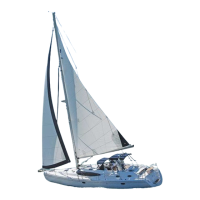nt
r
• Boatin
Safet
4.1
I
ou can
et at the
ire, aim the
ire extin
uisher at the
base o
the
lames and use a sweepin
action to put out
th
fir
.
I
the
ire
ets out o
control, make a distress si
nal and
all for hel
on the radio.
ecidin
whether to sta
with the boat or abandon ship
will be difficult. If the decision is to abandon shi
, all
er-
sons on board should
ump overboard and swim a sa
e
distance awa
rom the burnin
boat
.5 Distress Si
nal
.5.1 Ma
da
If
ou have a VHF radio, heed storm warnin
s and
answer an
distress calls from other boats. The word
MAYDAY” spoken three times is the international si
nal
f distress. Monitor marine radio channel 16, which is
reserved for emer
enc
and safet
messa
es. You can
also use this channel to contact the
oast
uard or other
boaters if
ou have trouble
Never send a “MAYDAY” message unless there is a serious
emergency and you are in need of immediately assistance.
.5.2 Visual Distress Si
nals
The U.
.
oast
uard requires that all boats operat-
in
on U.S. Coastal Waters have visual distress si
nal
qu
pment on
oar
.
n
enera
, coasta
waters
nc
u
e
all waters except rivers, streams, and inland lakes. The
reat Lakes are considered coastal waters, as is a river
m
t
m
r
t
n tw
m
w
.
t
wn
n t
nited
tates and operatin
on the hi
h seas must also
arr
visual distress si
nal equipment
isual distress equipment must be in serviceable con-
dition and stowed in a readil
accessible location.
quipment havin
a date showin
useful service life must
be within the speci
ied usa
e date shown. Both p
rotech-
nic and non-p
rotechnic equipment must be U.
.
oast
Guard a
roved
rotechnic U.
.
oast
uard approved visual distress
si
nals and associated equipment include: Red flares,
handheld or aerial
ran
e smoke, hand held or
loatin
Launchers
or aerial red meteor or parachute
lares. Non-
p
rotechnic equipment includes an oran
e distress fla
,
d
e markers, and an electric distress li
ht.
No sin
le si
nalin
device is ideal under all conditions
or
all purposes.
onsider carr
in
various t
pes o
equip-
ment. Careful selection and proper stowa
e of visual
distress equipment is ver
important. I
oun
children
are
requentl
aboard,
ou should select devices with
packa
es which children, but not adults, will find difficult
to open
ther hel
ful
ublications available from the U. S. Coast
uard include
Aids to Navi
ation”
U.
.
oast
uard
pamphlet
123
, which explains the si
ni
icance o
various li
hts and buo
s, the “Boatin
Safet
Trainin
anual”, and
Federal Requirements
or Recreational
Boats”.
heck with
our local
oast
uard
tation,
our
new
ea
er, or a
oca
mar
na a
out nav
at
ona
a
s
unique to
our area
.5.3 Runnin
and Navi
ation Li
ht
Your boat must have runnin
and navi
ation li
hts
or
safe operation after dark.
bserve all navi
ation rules
or meetin
and passin
. Do not run at hi
h speeds dur-
in
ni
ht operation. Alwa
s use common sense and
ood
u
ment.
peratin
at ni
ht can present some special challen
es.
ot on
s
our
ept
percept
on
essene
,
r
t
ts
n the shore can cast misleadin
re
lections on the water
and i
ou wear
lasses, or worse
et, bi
ocals,
ou sim-
pl
don
t see as well at ni
ht as
ou do durin
the da
.
It is not onl
important that
ou be able to identi
other
vessels operatin
in
our proximit
, it is equall
important
t
at ot
er vesse
s see
ou.
ost recreat
ona
vesse
s are
less than 30
eet in len
th and, accordin
to
The Rules
the Road”, shall be equipped with navi
ation li
hts.
ese
ts not on
ave a certa
n arc t
rou
w
c
the
can be seen but must be seen
rom a minimum dis-
tance. Fi
. 4.8, on pa
e 4.14 will show
ou the
ollowin
li
htin
requirements for recreational vessels both less
than 12 meters in len
th
approximatel
39.4”
, and over
12 meters in len
th to 20 meters
65'
Li
h
r
olor
i
i
l
an
t
Ligh
22
tarboar
.
r
P
r
ideli
h
112.
ternli
h
Wh

